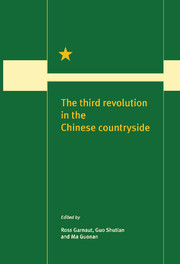Book contents
- Frontmatter
- Contents
- Figures
- Maps
- Tables
- Contributors
- Preface
- 1 The third revolution
- Feeding the people
- Marketing and price reform
- Internationalisation
- Regional issues
- 15 The grain economy of Guangdong: internationalisation or East Asian style protectionism?
- 16 Grain production and regional economic change
- 17 Regional inequality in rural development
- Institutional change
- References
- Index
17 - Regional inequality in rural development
from Regional issues
Published online by Cambridge University Press: 04 August 2010
- Frontmatter
- Contents
- Figures
- Maps
- Tables
- Contributors
- Preface
- 1 The third revolution
- Feeding the people
- Marketing and price reform
- Internationalisation
- Regional issues
- 15 The grain economy of Guangdong: internationalisation or East Asian style protectionism?
- 16 Grain production and regional economic change
- 17 Regional inequality in rural development
- Institutional change
- References
- Index
Summary
China aims to become a medium-income economy by the year 2000. For rural residents, unlike those in urban regions, this goal seems very distant, especially for those in the vast inland areas of central and western China. While in many coastal regions the rural population enjoys a standard of living comparable to that in urban areas, a large proportion of farmers in central and western China struggle hard to make ends meet. This regional development gap has continued to widen in the past decade.
Regional features of the rural economy
There are obvious differences in income and consumption levels among regions (Table 17.1). The most developed provinces are found along the eastern coast. Shanghai heads the list, with a per capita income level in 1991 of over 2,000 yuan for its rural resident population. It is followed by Beijing, Zhejiang, Tianjin and Guangdong, with income levels between 1,100 and 1,400 yuan. Other coastal provinces including Jiangsu, Liaoning, Fujian and Shandong also have income levels above the national average. Income levels in the inland regions are much lower. In the poorest provinces of Gansu, Anhui and Guizhou, incomes average around 500 yuan. Other lower-income regions are Inner Mongolia, Shaanxi, Henan, Qinghai, Shanxi and Yunnan, where per capita rural incomes in 1991 were less than 600 yuan.
Consumption levels are closely correlated with income levels. Per capita consumption of high-value food products and ownership rates for colour television sets, for instance, are much higher in the coastal regions than in the inland provinces.
- Type
- Chapter
- Information
- The Third Revolution in the Chinese Countryside , pp. 242 - 252Publisher: Cambridge University PressPrint publication year: 1996
- 1
- Cited by

